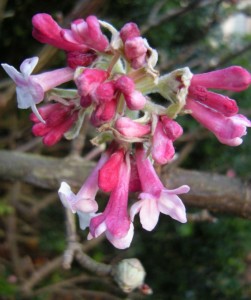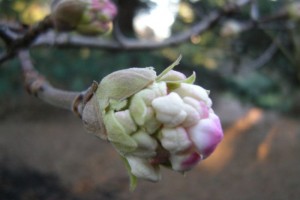At elongated bud stage the petals of Viburnum grandiflorum have the shape and intensity of colour of a red lipstick. Holding an exceptional heady fragrance the tubular corolla fades to rose then white on ageing. The dominant silvery lichen growing profusely on the shoots is a mixture of two closely-related species: Physcia adscendens and Physcia tenella. The yellow lichen is Xanthoria parietina.
A stout plant with stocky growth this deciduous shrub produces clusters of flowers from terminal buds.
The plant in the border to the south of the Queen Mothers Memorial Garden is covered in silvery lichen. Raised from a plant collected by Roland Cooper growing amongst Conifers and Rhododendron at c. 4000m in the Thimpu region of Bhutan.
Cooper was funded on this and other trips by A.K.Bulley, a Liverpool cotton trader of great wealth. He also funded other plant collectors to mainly temperate regions of Asia for 20 years from 1904.
On return the seeds from these expeditions were distributed to many gardens and collections through Britain. Bulley, in 1911, founded the seed firm Bees which put much new material into cultivation through private gardens in Britain. His garden on the Wirral was gifted to Liverpool University becoming known as Ness Botanic Garden. Cooper went on to be superintendent of Maymyo Botanic Garden, Burma in 1921. In 1930 he joined the staff of RBGE as assistant curator, promoted to curator in 1934 remaining here until retirement in 1950.
There are two other specimens of V. grandiflorum growing in the garden. Neither matches Cooper’s collection for intensity of flower colour. In 1915 Ludlow Sherriff & Hicks collected seed at a lower elevation c.3000 metres also in Bhutan. In 1985 Ron McBeath collected in India, from Himachal Pradesh at 650m. In this area V. grandiflorum was a common shrub growing with Quercus and Pinus.


